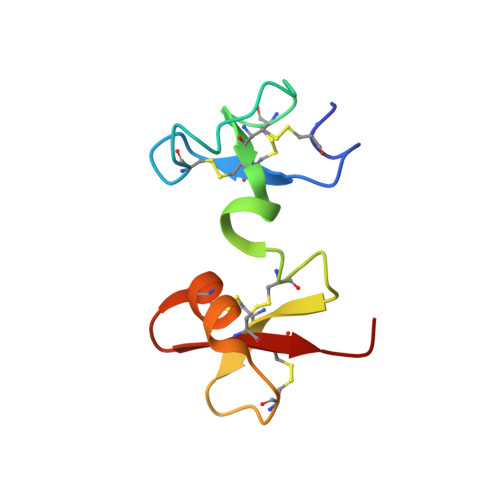The NMR structure and dynamics of the two-domain tick carboxypeptidase inhibitor reveal flexibility in its free form and stiffness upon binding to human carboxypeptidase B.
Pantoja-Uceda, D., Arolas, J.L., Garcia, P., Lopez-Hernandez, E., Padro, D., Aviles, F.X., Blanco, F.J.(2008) Biochemistry 47: 7066-7078
- PubMed: 18558717
- DOI: https://doi.org/10.1021/bi800403m
- Primary Citation of Related Structures:
2JTO - PubMed Abstract:
The structure of the tick carboxypeptidase inhibitor (TCI) and its backbone dynamics, free and in complex with human carboxypeptidase B, have been determined by NMR spectroscopy. Although free TCI has the same overall fold as that observed in the crystal structures of its complexes with metallocarboxypeptidase types A and B, there are structural differences at the linker between the two domains. The linker residues have greater flexibility than the globular domains, and the C-terminal residues are highly flexible in free TCI. Upon formation of a complex with carboxypeptidase B, TCI becomes more rigid, especially at the level of the linker and at the C-terminus, which is inserted into the active site groove of the carboxypeptidase. Solvent exchange rates of the backbone amide protons also show a strong reduction of the local TCI dynamics and a stabilization of its structure upon complex formation. The findings are consistent with a recognition mechanism that primarily involves the C-terminal domain, which adjusts its conformation and that of the linker, thus facilitating complex stabilization by further interactions between the N-terminal domain and an exosite of the carboxypeptidase. This adaptability enables TCI to tune its global conformation for proper interaction with distinct types of carboxypeptidases by a mechanism of induced fit. Our results provide new information about the structure-function relationship and stability of a molecule with potential biomedical applications in thrombolytic therapy. Furthermore, the plasticity of TCI makes it an ideal scaffold for developing stronger and/or more specific inhibitors directed toward modulating the activity of metallocarboxypeptidases.
Organizational Affiliation:
Instituto de Quimica-Fisica Rocasolano, CSIC, Serrano 119, 28006 Madrid, Spain.














